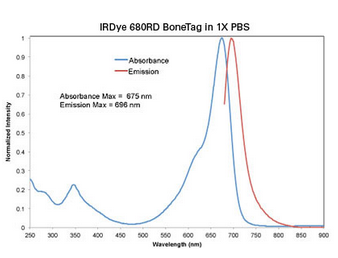IRDye 680RD BoneTag Optical Probe is a calcium-chelating compound conjugated to IRDye 680RD near-infrared dye. Using IRDye NIR dyes extends fluorescence signal detection to the near-infrared fluorescent region of the spectrum without affecting the compound’s ability to function as a marker of the mineralization process. NIR fluorescence detection improves depth of penetration due to low tissue autofluorescence, translating to low background interference.
Calcium-chelating compounds have been used effectively for the detection of bone mineralization, growth, and morphological changes, including tetracycline derivatives, xylenol orange, alizarin, calcein, and fluorescein. NIR-labeled pamidronate has also been successfully used for detection of arterial calcification in non-invasive optical imaging1.
Learn about other LI-COR optical probes.
Applications
Absorbance and Emission Spectra

Data Example

References
- Zaheer A et al. (2001) In vivo near-infrared fluorescence imaging of osteoblastic activity. Nat Biotechnol, 19. 1148-54.
- Kovar, J. L., Xu, X., Draney, D., Cupp, A., Simpson, M. A., & Michael Olive, D. (2011). Anal Biochem, 416(2), 167–173. doi: 10.1016/j.ab.2011.05.011.
